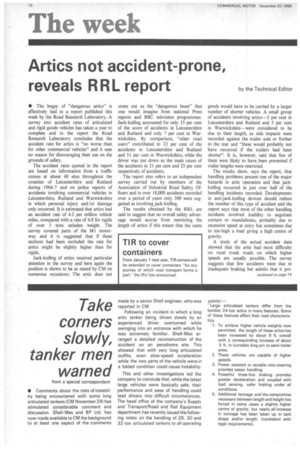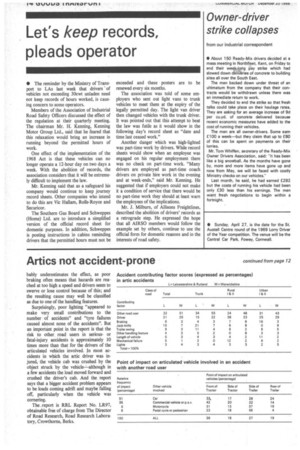Artics not accident-prone,
Page 14

Page 16

If you've noticed an error in this article please click here to report it so we can fix it.
reveals R R L report by the Technical Editor
• The bogey of "dangerous artics" is effectively laid in a report published this week by the Road Research Laboratory. A survey into accident rates of articulated and rigid goods vehicles has taken a year to complete and in the report the Road Research Laboratory concludes that the accident rate for artics is "no worse than for other commercial vehicles" and it sees no reason for discouraging their use on the grounds of safety.
The accident rates quoted in the report are based on information from a traffic census at about 40 sites throughout the counties of Leicestershire and Rutland during N1966-7 and on police reports of accidents involving commercial vehicles in Leicestershire, Rutland and Warwickshire in which personal injury and /or damage only occurred. It is estimated that ernes had an accident rate of 4.2 per million vehicle miles, compared with a rate of 4.8 for rigids of over 5 tons unladen weight. The survey covered parts of the MI motorway and it is suggested that if these sections had been excluded the rate for artics might be slightly higher than for rigids.
Jack-knifing of artics received particular attention in the survey and here again the position is shown to be as stated by CM on numerous occasions: The attic does not
come out as the "dangerous beast" that one would imagine from national Press reports and BBC television programmes. Jack-knifing accounted for only 15 per cent of the score of accidents in Leicestershire and Rutland and only 7 per cent in Warwickshire. By comparison, "other road users" contributed to 32 per cent of the accidents in Leicestershire and Rutland and 51 per cent in Warwickshire, while the driver was put down as the main cause of the accidents in 21 per cent and 25 per cent respectively of accidents.
The report also refers to an independent survey carried out by members of the Association of Industrial Road Safety Officers and in over 18,000 accidents recorded over a period of years only 300 were suggested as involving jack-knifing.
The results obtained by the RRL are said to suggest that no overall safety advan tage would accrue from restricting the length of artics if this meant that the same goods would have to be carried by a larger number of shorter vehicles. A small group
of accidents involving attics 5 per cent in Leicestershire and Rutland and 3 per cent in Warwickshire—were considered to be due to their length, as side impacts were recorded against the trailer axle or further to the rear and "these would probably not have occurred if the trailers had been shorter". It is, however, said that few of them were likely to have, been prevented if trailer lengths were restricted.
The results show, says the report, that handling problems present one of the major hazards in attic operation and that jackknifing occurred in just over half of the handling incidents recorded. Developments in anti-jack-knifing devices should reduce the number of this type of accident and the report says that most of the other handling incidents involved inability to negotiate corners or roundabouts, probably due to excessive speed at entry but sometimes due to too-high a load giving a high centre of gravity.
A study of the actual accident data showed that the attic had most difficulty on rural trunk roads on which higher speeds are usually possible. The survey suggests that few accidents were due to inadequate braking but admits that it pro bably underestimates the effect, as poor braking often means that hazards are reached at too high a speed and drivers seem to swerve or lose control because of this; and the resulting cause may well be classified as due to one of the handling features.
Surprisingly, poor lighting "appeared to make very small contributions to the number of accidents" and "tyre failures caused almost none of the accidents". But an important point in the report is that the risk to other road users in seriousor fatal-injury accidents is approximately 10 times more than that for the drivers of the articulated vehicles involved. In most accidents in which the artic driver was injured, the vehicle cab was crushed by the object struck by the vehiele-Lalthough in a few accidents the load moved forward and crushed the driver's cab. And the report says that a bigger accident problem appears to be loads coming adrift and maybe falling off, particularly when the vehicle was cornering.
The. report is RRL Report No. LR97, obtainable free of charge from The Director of Road Research, Road Research Laboratory, Crowthorne, Berks.


























































































